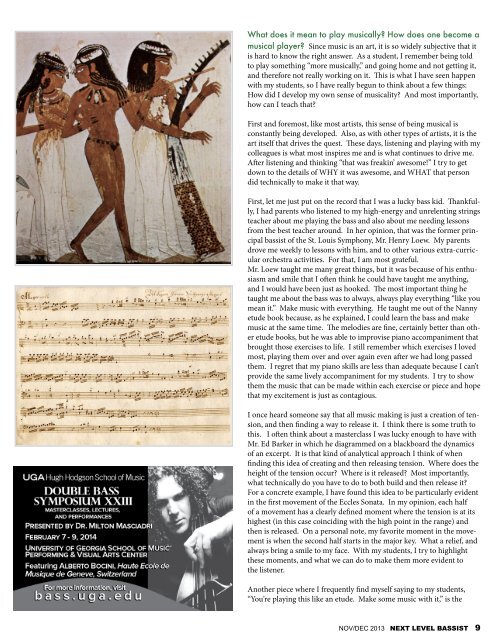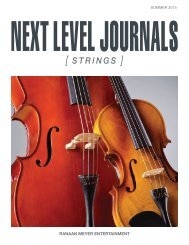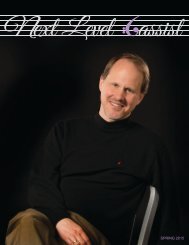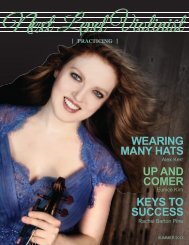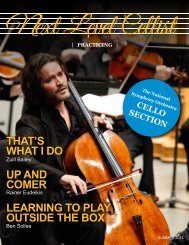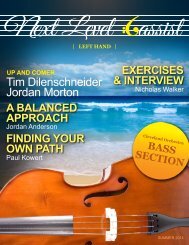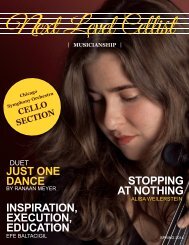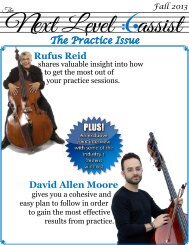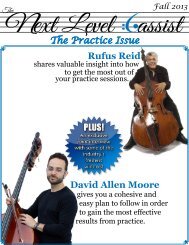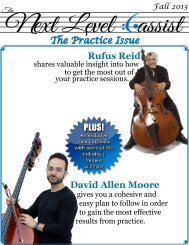Next Level Bassist Musicality Issue
Articles by Sarah Hogan and John Patitucci, Spotlight on the Pittsburgh Symphony, Double Stop Strum by Ranaan Meyer
Articles by Sarah Hogan and John Patitucci, Spotlight on the Pittsburgh Symphony, Double Stop Strum by Ranaan Meyer
Create successful ePaper yourself
Turn your PDF publications into a flip-book with our unique Google optimized e-Paper software.
What does it mean to play musically? How does one become a<br />
musical player? Since music is an art, it is so widely subjective that it<br />
is hard to know the right answer. As a student, I remember being told<br />
to play something “more musically,” and going home and not getting it,<br />
and therefore not really working on it. This is what I have seen happen<br />
with my students, so I have really begun to think about a few things:<br />
How did I develop my own sense of musicality? And most importantly,<br />
how can I teach that?<br />
First and foremost, like most artists, this sense of being musical is<br />
constantly being developed. Also, as with other types of artists, it is the<br />
art itself that drives the quest. These days, listening and playing with my<br />
colleagues is what most inspires me and is what continues to drive me.<br />
After listening and thinking “that was freakin’ awesome!” I try to get<br />
down to the details of WHY it was awesome, and WHAT that person<br />
did technically to make it that way.<br />
First, let me just put on the record that I was a lucky bass kid. Thankfully,<br />
I had parents who listened to my high-energy and unrelenting strings<br />
teacher about me playing the bass and also about me needing lessons<br />
from the best teacher around. In her opinion, that was the former principal<br />
bassist of the St. Louis Symphony, Mr. Henry Loew. My parents<br />
drove me weekly to lessons with him, and to other various extra-curricular<br />
orchestra activities. For that, I am most grateful.<br />
Mr. Loew taught me many great things, but it was because of his enthusiasm<br />
and smile that I often think he could have taught me anything,<br />
and I would have been just as hooked. The most important thing he<br />
taught me about the bass was to always, always play everything “like you<br />
mean it.” Make music with everything. He taught me out of the Nanny<br />
etude book because, as he explained, I could learn the bass and make<br />
music at the same time. The melodies are fine, certainly better than other<br />
etude books, but he was able to improvise piano accompaniment that<br />
brought those exercises to life. I still remember which exercises I loved<br />
most, playing them over and over again even after we had long passed<br />
them. I regret that my piano skills are less than adequate because I can’t<br />
provide the same lively accompaniment for my students. I try to show<br />
them the music that can be made within each exercise or piece and hope<br />
that my excitement is just as contagious.<br />
I once heard someone say that all music making is just a creation of tension,<br />
and then finding a way to release it. I think there is some truth to<br />
this. I often think about a masterclass I was lucky enough to have with<br />
Mr. Ed Barker in which he diagrammed on a blackboard the dynamics<br />
of an excerpt. It is that kind of analytical approach I think of when<br />
finding this idea of creating and then releasing tension. Where does the<br />
height of the tension occur? Where is it released? Most importantly,<br />
what technically do you have to do to both build and then release it?<br />
For a concrete example, I have found this idea to be particularly evident<br />
in the first movement of the Eccles Sonata. In my opinion, each half<br />
of a movement has a clearly defined moment where the tension is at its<br />
highest (in this case coinciding with the high point in the range) and<br />
then is released. On a personal note, my favorite moment in the movement<br />
is when the second half starts in the major key. What a relief, and<br />
always bring a smile to my face. With my students, I try to highlight<br />
these moments, and what we can do to make them more evident to<br />
the listener.<br />
Another piece where I frequently find myself saying to my students,<br />
“You’re playing this like an etude. Make some music with it,” is the<br />
NOV/DEC 2013 NEXT LEVEL BASSIST<br />
9


